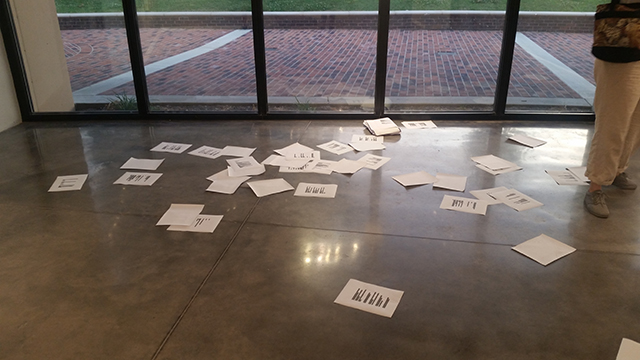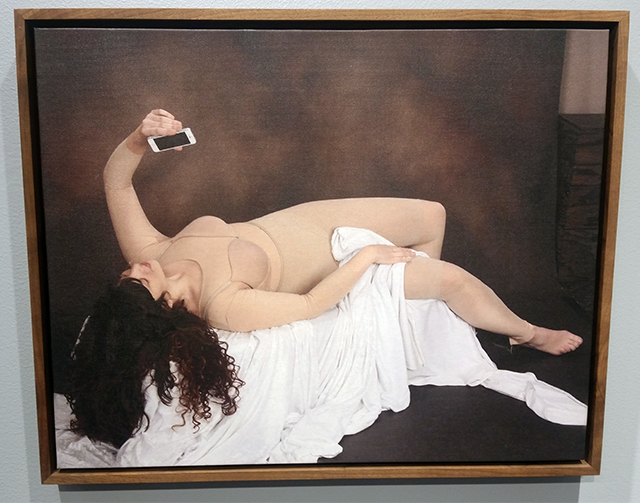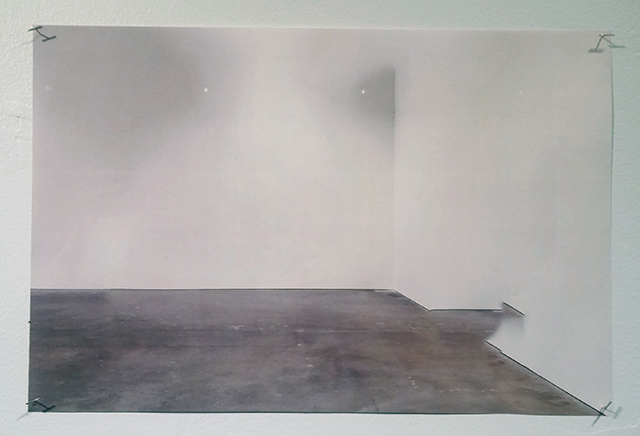
Detritus from SOFIA RETA Corporation’s ” T AND T A N AND C,” paper and ink, 2016.
Love Me and Delete Me
Curated by Anoushe Shojae-Chaghorvand
CCBC Essex Gallery
7201 Rossville Blvd, Rosedale, MD
On view until September 10th
Artists: Kyle England, Andy Storrs, Stephanie Barber, Joshua Sender, SOFIA RETA Corporation, Nicki Apostolow Weaver, Zoe Burke, Killian Barnes, Lexie Mountain, Maralie, Esteban, Matt DeLong, and Kory Shoja-Chaghorvand
I arrived late to the opening reception of Love Me and Delete Me. The gallery is located on a community college campus in a not-very-convenient suburb outside Baltimore. By the time I found it, performance artists and noise musicians had finished their sets and were smoking outside on the otherwise deserted brutalist campus. The scene looked as if it had been plucked from a low-budget post-apocalyptic sci fi film from the 80s. It was an appropriately dystopian prelude to an exhibition about technology and isolation.
Curator Anoushe Shojae-Chaghorvand spends a lot of time on social media—it’s easy to imagine her checking her phone compulsively on the long bus commute back and forth from the city—waiting for a response, some validation that she hasn’t been forgotten in these stretches of dead time. Love Me and Delete Me, a video-and-performance-heavy group show with a decidedly DIY sensibility, is full of work that describes this anxiety: the unconfident selfie, documentation that strives for absurd perfection, and self-effacing video art collectively read as muted digital cries for attention. The small gallery is densely-hung, but not overly so. It’s a refreshingly aesthetically diverse show, for the “post-internet” genre. A small screening area cycles through video work, and smaller 2D works are tucked along wallspace framing areas for performance.

Lexie Mountain, “Woman With Smartphone,” digital print on canvas, 2014.
In Lexie Mountain’s self portrait “Woman With Smartphone,” we see the artist clad in layers upon layers of body-shapers, reclining in garments that describe themselves as “nude” in a recreation of Courbet’s iconic “Woman with a Parrot”. Here, though, she’s gazing at herself in an iPhone. The image was shot in a JCPenny photography studio, digitally retouched to mimic an oil painting, and printed on canvas. It’s a subtly striking conglomeration of aspirational signifiers. The idealized body, the idealized art historical reference, and the idealized selfie are presented as comically out-of-reach—despite the various layers of consumer intervention.
Similarly, Joshua Sender’s work waxes poetic on the impossibility of the perfect image. The artist describes his “Documents” series:
Installation shots are a show of power and place an image within a new set of expectations…But why bother creating more than documentation of digital images or objects? …The implied object never delivers on the promises of its potential, but also doesn’t need to.

Joshua Sender, “New Work,” digital image. 2015.
The images on display, from the sub-series “New Work,” are virtually indistinguishable from David Hanes’ “Aware” series, in which installation shots of contemporary art spaces are retouched using Photoshop’s “Content-Aware Fill” tool (a process AFC commissioned Hanes to replicate with our images of last year’s Frieze art fair). In both cases, the white cube collapses in on itself into a vague nebula of architecture that signifies the presence of artwork, uncannily stripped of objects and spatial logic. These erased images (which have grown into somewhat of a genre, apparently) are oddly seductive and frustrating. The spaces are just realistic enough to “enter” as a viewer, but too unstable to fully place oneself within. They suggest content, but offer none.
Denying a viewer’s expectation of content is a tactic that’s employed in a lot of the work here, an apt parallel to the bait-clicking demands of internet users. SOFIA RETA Corporation’s epic ” T AND T A N AND C” is probably the funniest example of this—the art collective sent the original English script for James Cameron’s Titanic to a Serbian translation service. From Serbian, it was translated to French. The French script was then reverted to English using Google Translate, which produced a predictably illegible document, available for download here.
In true SOFIA RETA Corporation fashion, a reading of the script was subcontracted to local performance artists, who were quite drunk by the time I arrived. They loudly shouted the nonsensical dialogue and stage directions to the crowd, pulling pages from a stack on the floor and scattering each one after it was read. I was encouraged to pick one up, which read:
for the men who are watching the ready to derail the boat. Several of the people is the break and do not rush to
forward.
The fate of the Lightoller his revolver appears Webley and has a goal to them.
The return of LIGHTOLLER! Maintenance of order!
The men to return to the bottom. The fifth Officer Lowe standing in the boat, Cree
to crew.
LOWE
Is far less than the left and right!
For anyone who lived through the seemingly-endless global cultural dominance of Titanic in the late Nineties, seeing the film dismantled is a cathartic experience. And the gesture has a vaguely autobiographical undercurrent, despite the artists’ best attempts at obfuscating authorship—SOFIA RETA Corporation presents itself as a slick, warped mirror of mainstream consumer culture who prefer to downplay individual identities, but the founding member of the polyglot collective grew up in Serbia. They undoubtedly had to suffer through many a badly-dubbed Hollywood blockbuster.
Cinema—and the expectations its influence has placed upon the moving image—is also at the core of Stephanie Barber’s work. Of her short videos, the 37-second “Tears or Rain or Something That Falls” struck me as particularly poignant. The video depicts an animated rainstorm on a screen, shot from a slight angle to reinforce to idea that the viewer/camera is an audience member witnessing another screening. A rude voice suddenly interrupts the silent projection “IT WAS JUST A MOVIE ABOUT TEARS OR RAIN OR SOMETHING THAT FALLS… I LEFT!” I’m often struck by Barber’s ability to make work that’s smart with a sense of humor about failure, narrative, or communication. She’s used YouTube comment culture as source material before, and it’s easy to imagine the animation in “Tears or Rain or Something That Falls” as a painfully sincere piece of video art that would be dismissed by the average internet user.
And the biggest irony of Love Me and Delete Me is that it’s a thoughtful IRL exhibition about the desire for recognition that will likely not be physically seen by many people. It’s a show about loneliness and visibility taking place in the summer off-months at a campus beyond the city’s fringe. There’s an online component, but many of the works, such as Killian Barnes’ Instagram-shaped painting of the “100” emoji in a step-and-repeat pattern, really need to be viewed in person. The viscous surface and layers of frenzied brushstrokes disappear in photographs, a poetic injustice to an artwork of (and likely, for) the internet. Documentation seldom does justice to paintings, or life, as the exhibition reminds us.


Comments on this entry are closed.